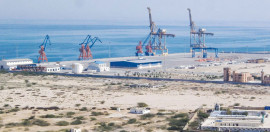
The Gwadar port has been in the news for more than one decade. The images of the area and the city which I had access to so far, like many other Pakistanis, was only through real estate ads by different companies, firms and development agencies. They had sold tracts of inhospitable desert by copy-pasting the skyscrapers of Dubai and other Gulf cities in newspaper advertisments. The business of selling and buying went on and on for a good number of years. I am not sure if investors from other parts of the country had ever visited the area or the city. The lands were sold on the prospects of building a new port city and the speculative value of the properties in which they had invested. I wanted to visit the city for other reasons, but also to see if the city on the ground matched the Dubai posters which are now occasionally displayed around the country.
I had the opportunity to spend three days of the last weekend to see for myself what I would love to term as the future of Balochistan, of the people from that province and of Pakistan, of course. By walking around the Koh-e-Batil that overlooks the port, the city and the blue waters of the Balochistan Sea — forgive me for substituting it for the Arabian Sea — for several hours, I have been able to form a good impression. My informal conversations with colleagues and hosts from Turbat University have added a great deal to my understanding of the region. The physical character of Gwadar and its geographical location may be termed a jewel of Balochistan: a jewel that has remained hidden from the attention of our successive regimes. Why did they ignore it? I have some explanation but would leave it for other times. It would suffice to say that Gwadar, once developed, might eclipse the ports on the other side of the Balochistan Sea. And the interplay of regional power politics and the connivance of imported, installed and controlled leaders from strings pulled in foreign lands may offer some clues.
With hundreds of miles of open coast and a vast expanse of land through very sparsely populated regions, the white, unspoiled sand beaches, deep turquoise waters and abundance of fish present nature’s bounty, and a great reserve of resources to sustain generations. The real challenge, and the gravest one, is about transforming Gwadar, the Makran coast and the area from its raw potential into a thriving economy and hub of international trade and commerce. So far, the progress on the ground has been disappointing.

Let me start with the city, Gwadar, itself. It is not a city as I had imagined and whose fleeting images I had seen through the copy-pasted posters of Dubai. It is not even close to the amenities of the smaller towns in Punjab. There are no paved roads and streets and no sewerage system. One has to walk through a lot of flying garbage, dirt and tens of stray dogs. Water remains a scarce commodity. The goods sold in the shops and the commercial atmosphere of the ‘city’ speaks volumes about poverty, marginalisation and unemployment. The front of the city — the beaches — are dotted with donkey-carts collecting fish from the boats, most of which goes to Karachi for processing.
The corrupt deals on Gwadar port, like the real estate fantasy, have prevented a sustained and consistent development of the area. The plans we have on the table are fantastic — industrial and trade zones, power generation and the corridors linking the port with Xinxiang and exploiting the local water resources. The big question is: when will they translate into reality and what will be the stake and ownership of the local populations.
Published in The Express Tribune, April 16th, 2015.
Like Opinion & Editorial on Facebook, follow @ETOpEd on Twitter to receive all updates on all our daily pieces.































































COMMENTS (11)
Comments are moderated and generally will be posted if they are on-topic and not abusive.
For more information, please see our Comments FAQ